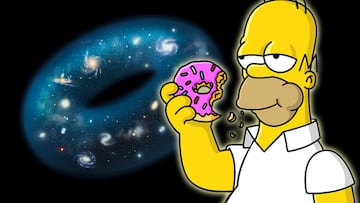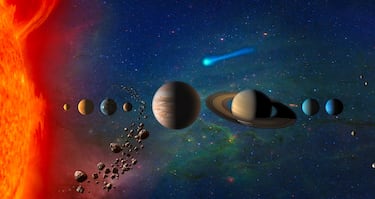Was Homer Simpson right? Why we might have a donut-shaped universe
More than 20 years ago, ‘The Simpsons’ offered a possible explanation for the shape of the universe thanks to a peculiar conversation between Homer and Stephen Hawking.

The true origin and shape of the universe are among the most intriguing mysteries in science. Despite numerous hypotheses, none have yielded conclusive or irrefutable results.
But what if Homer Simpson was right and the answer is simpler than we think? What if the universe is actually donut-shaped? In this text, we explore a theory suggesting that the universe is finite and without edges—a concept explained by its possible toroidal (donut-like) shape.
Homer Simpson’s “Proposed” Donut-Shaped Universe Theory
In the 22nd episode of the 10th season of The Simpsons, titled They Saved Lisa’s Brain, Homer encounters Stephen Hawking, the renowned theoretical physicist and cosmologist. During their conversation at Moe’s Tavern, Hawking humorously tells Homer that his “theory of a donut-shaped universe is very interesting” and jokes that he “might just steal it.” This light-hearted exchange adds a playful twist to an otherwise unexpected scientific discussion between the two.

Although it may initially seem like a simple joke at Homer’s expense, given his well-known love for donuts, Hawking’s comment carries a deeper meaning: the theory of a donut-shaped universe is, in fact, a real concept. Even though this episode aired in 1999, the idea of a toroidal universe hasn’t been entirely ruled out.
The notion that the universe could be shaped like a “donut,” or more precisely a torus in mathematical terms, is a fascinating possibility in modern cosmology. This hypothesis is rooted in theories of topology and theoretical physics. While it isn’t the most widely accepted model for explaining the shape of the universe and its potential boundaries, it continues to hold a place in scientific discussions today.
What Would a Donut-Shaped Universe Look Like?
Unlike the more common model of a flat, infinite, and edgeless universe, a torus-shaped universe would be finite and folded in on itself, yet still edgeless. In such a universe, traveling in a straight line for long enough would eventually bring you back to your starting point, much like walking around the surface of a 3D donut.

This assumption is part of the family of “non-intuitive” explanations for the shape and expansion of the universe, where instead of assuming that the universe is an infinite three-dimensional space, this space curves and twists on itself in very specific ways.
A torus could be one such model, allowing space to “wrap” around itself and offering justifications for astronomical phenomena such as anomalies in the expansion of the universe or the perception that it is a system in which cycles of expansion and contraction occur, in turn providing a new framework for theories of an oscillating universe.
What Scientific Evidence Supports a Donut- or Torus-Shaped Universe?
Currently, the idea of a donut-shaped universe remains purely theoretical, with no direct empirical evidence. However, two main avenues provide possible explanations for this unusual geometry:
- Topological Studies of the Universe: Topology examines how surfaces can be connected or folded. A torus-shaped universe would be finite but without boundaries—an idea that may seem paradoxical but is mathematically possible. In this model, space would wrap around itself, creating a continuous, edgeless structure.
- Studies of the Cosmic Microwave Background (CMB): The CMB, a remnant of the Big Bang, is a key piece of evidence for understanding the universe’s shape. If the universe has a toroidal geometry, light from the same source could appear in multiple locations simultaneously. This could provide clues to the universe’s possible structure.
While the notion of a torus-shaped universe is intriguing, the current consensus in cosmology favours the theory of a flat, infinite universe. This is largely based on observations of cosmic background radiation and the ongoing expansion of the universe.

Related stories
However, the possibility of a more exotic topology, such as a torus-shaped universe, has not been entirely ruled out. Even with the most advanced measuring instruments, there are significant technological limitations in the precision of measurements, preventing us from definitively dismissing these “alternative” theories regarding the universe’s shape.
In conclusion, while the idea of a donut-shaped universe remains a theoretical possibility, current observations neither confirm nor completely rule it out. It is a mathematically plausible and intriguing concept that continues to be actively explored and studied by leading researchers in the field. Homer, it seems, could still be correct.



Complete your personal details to comment